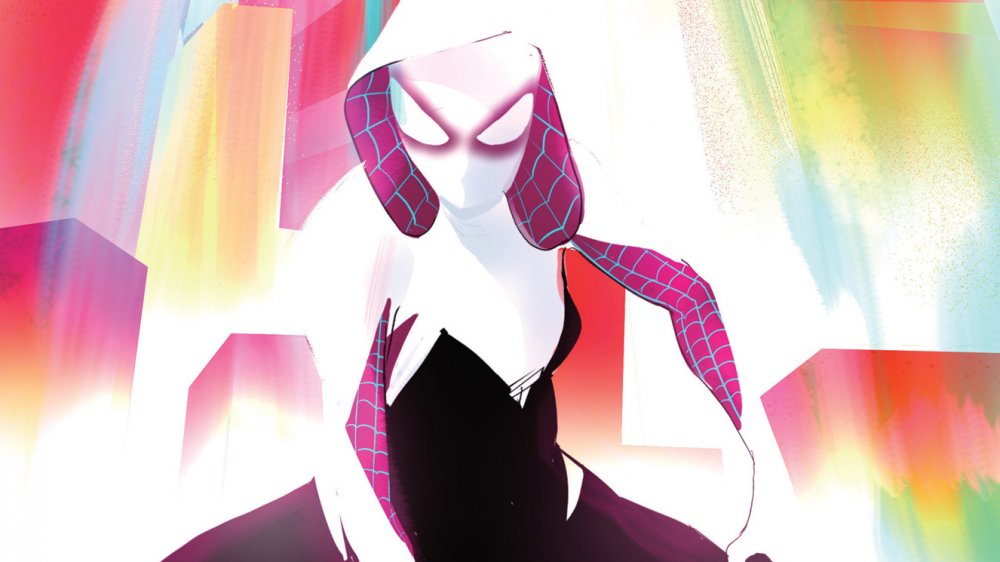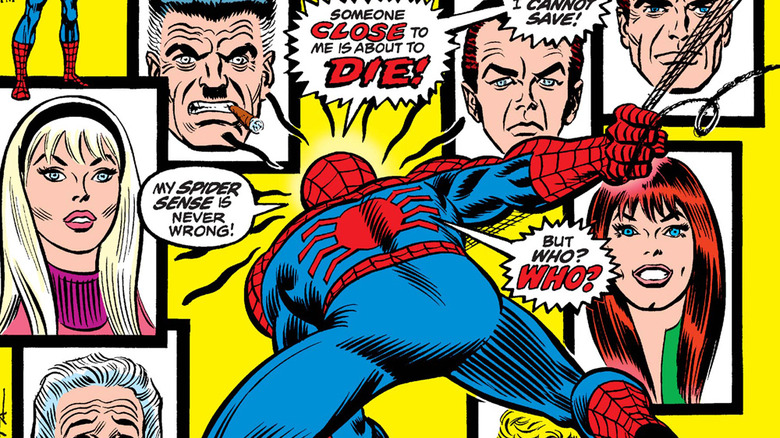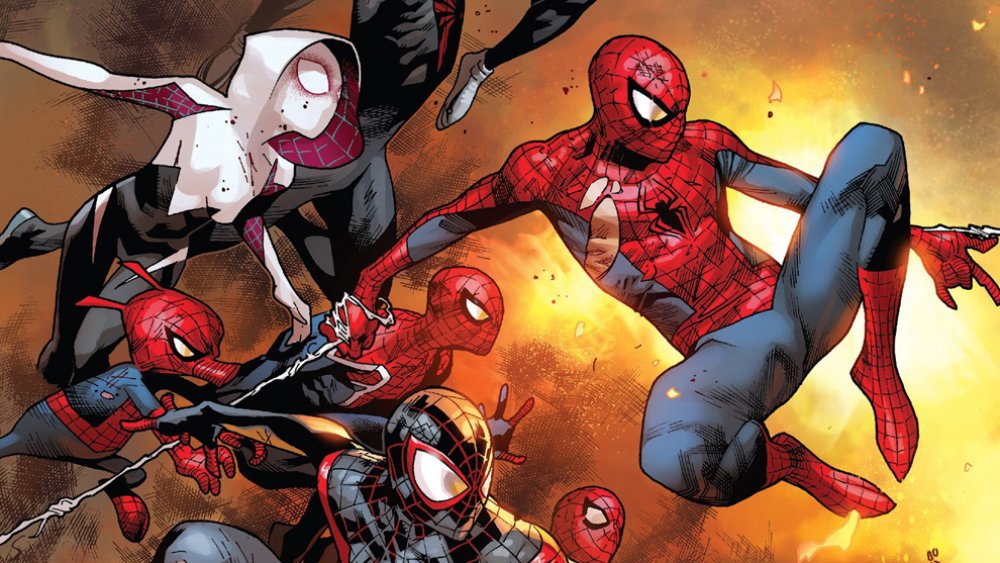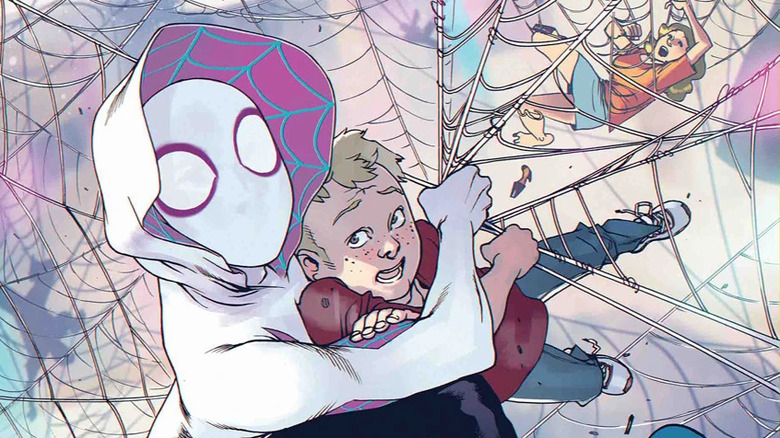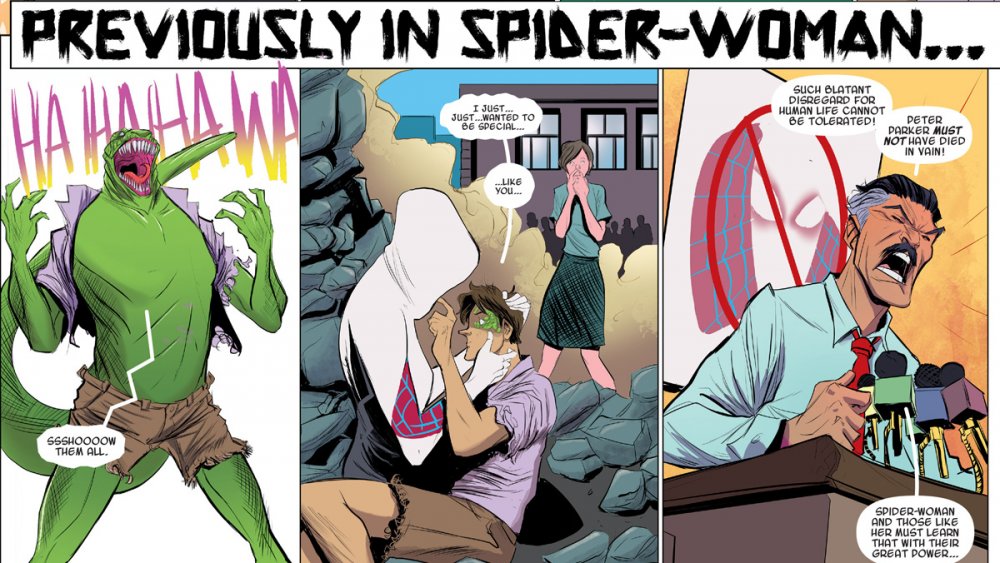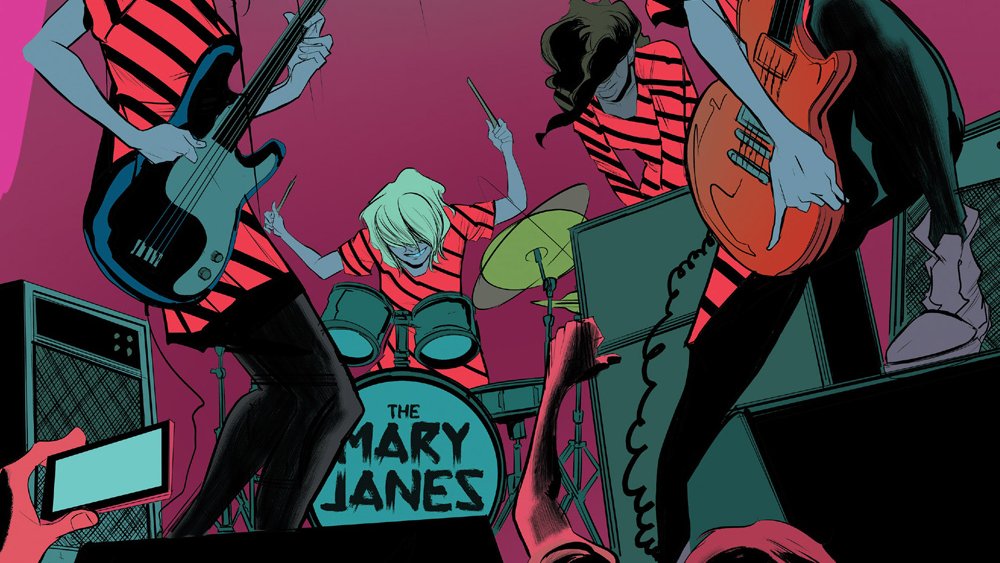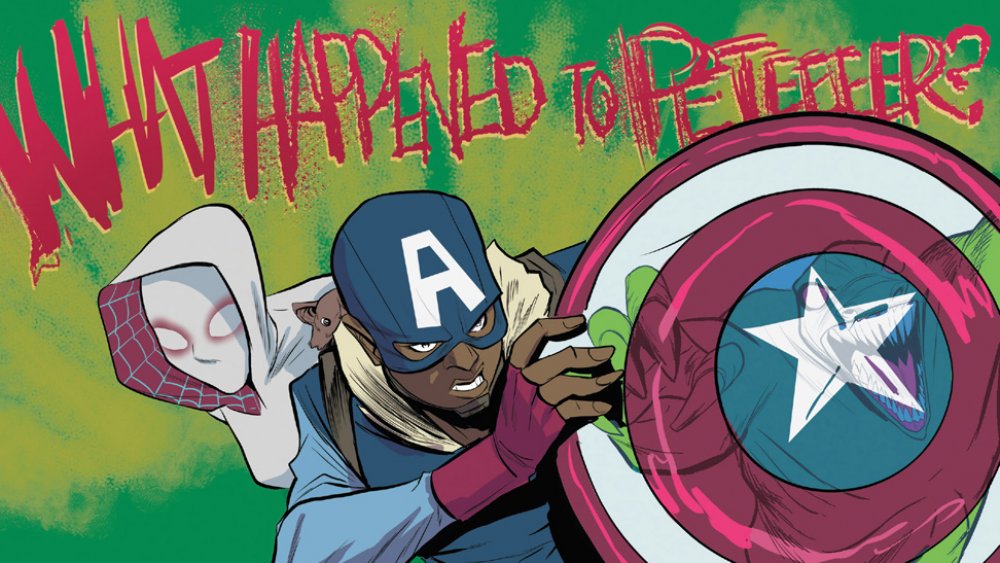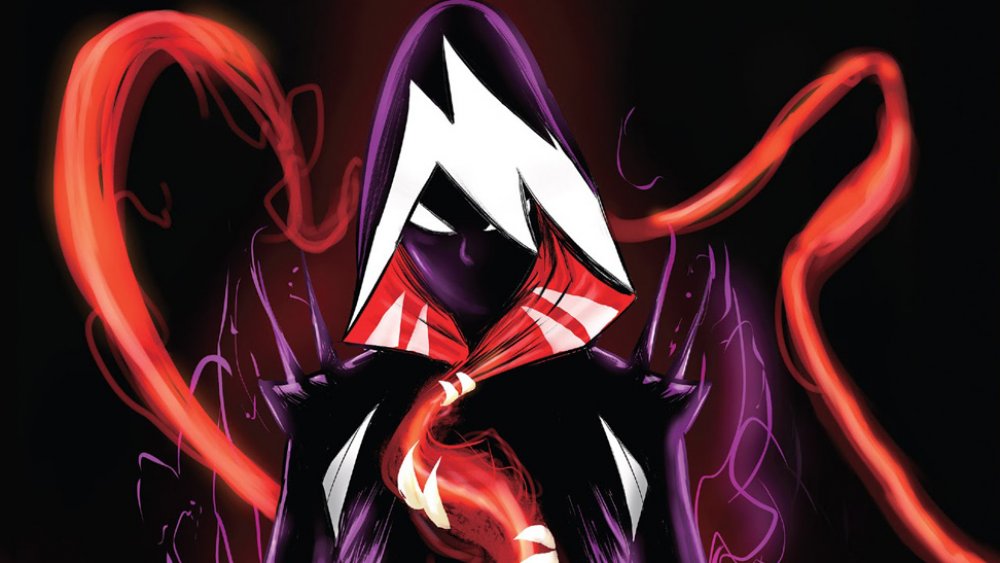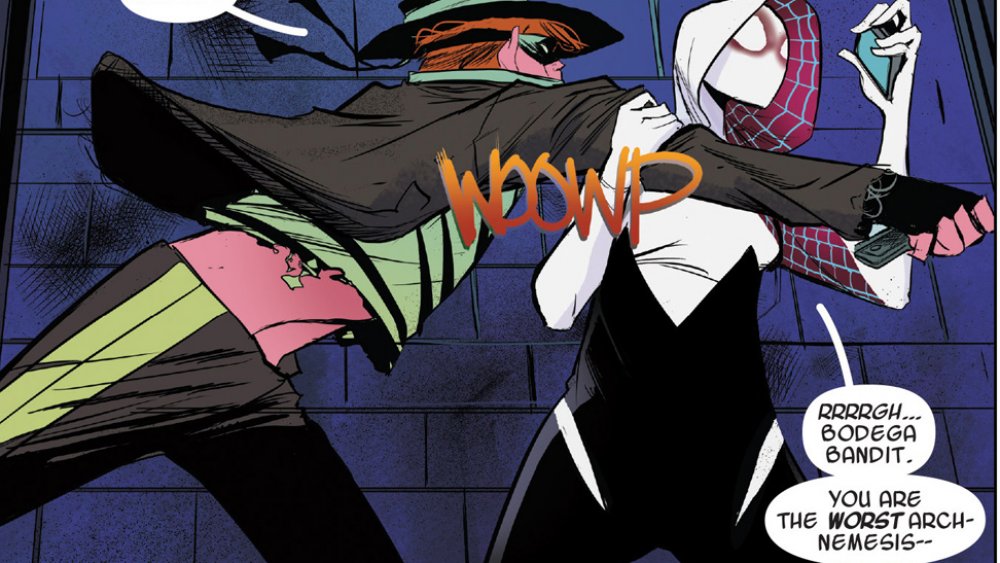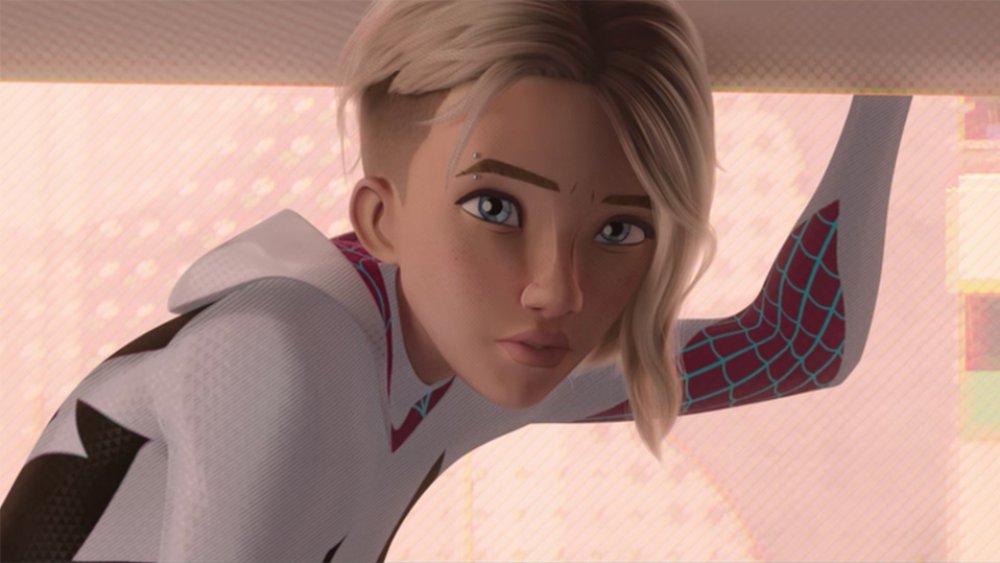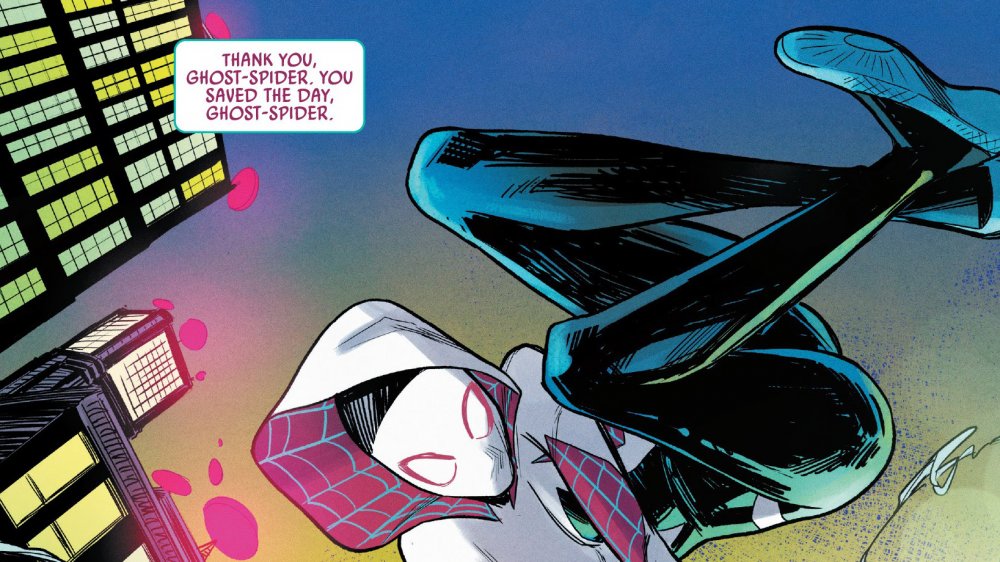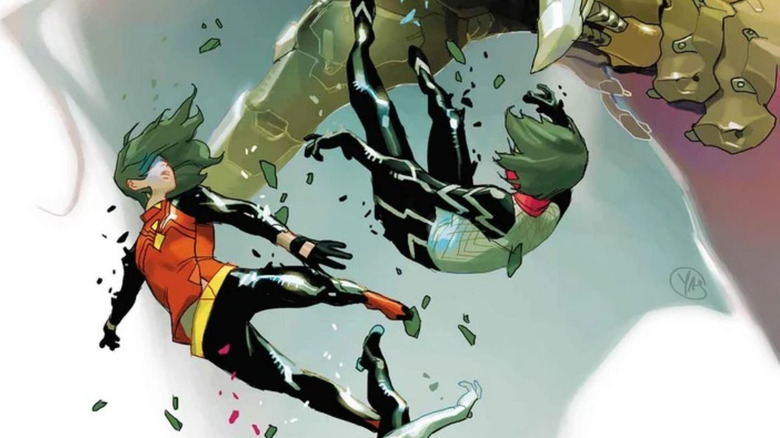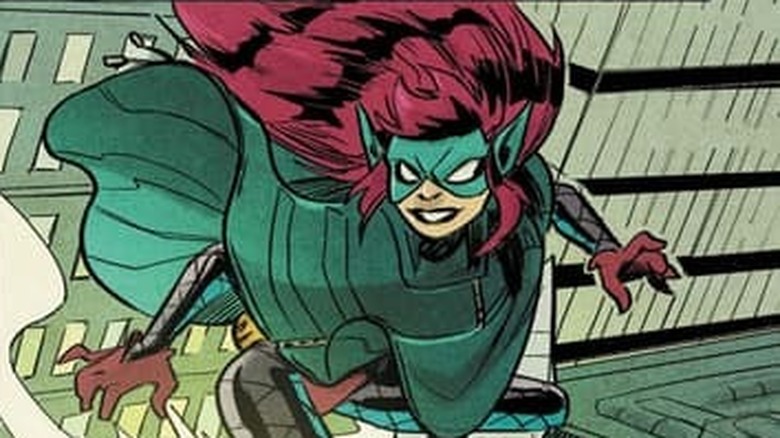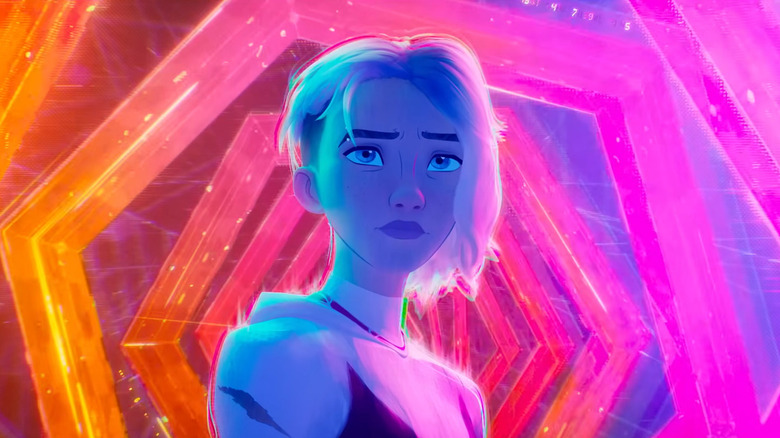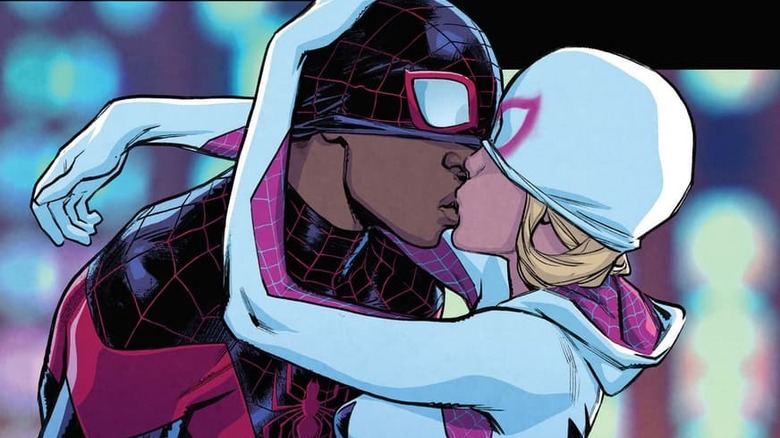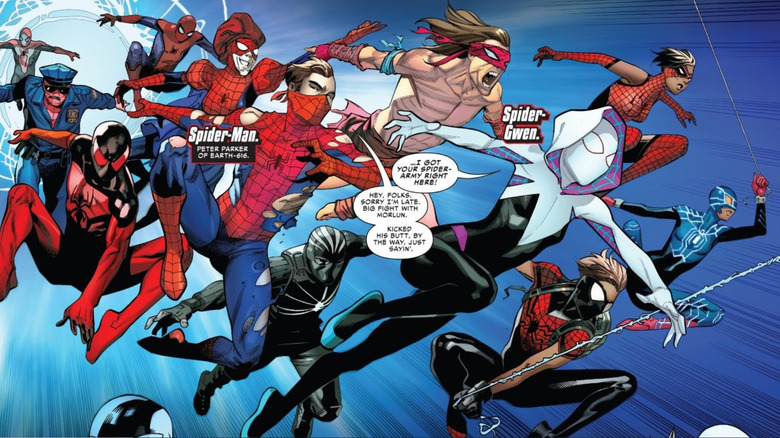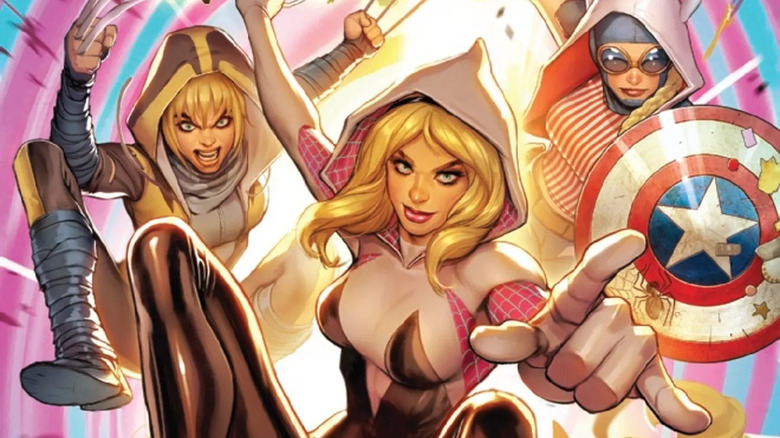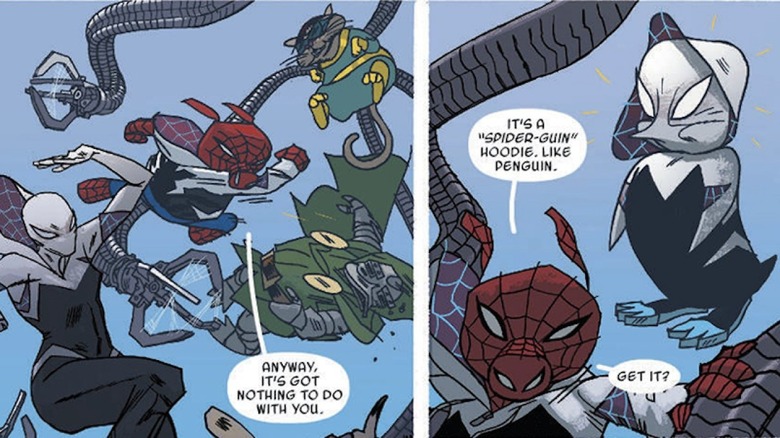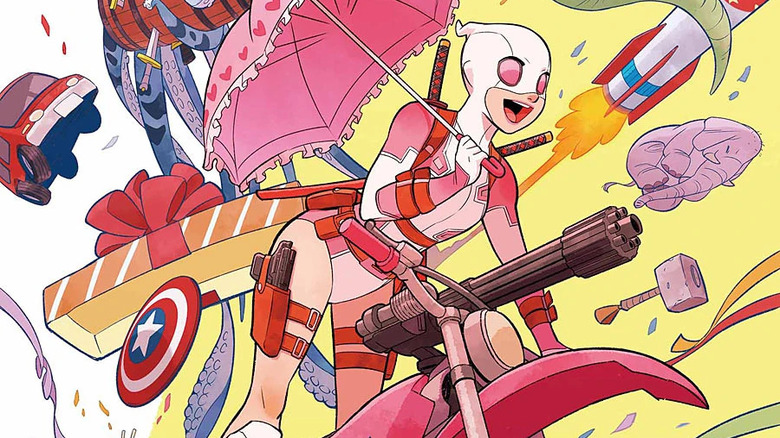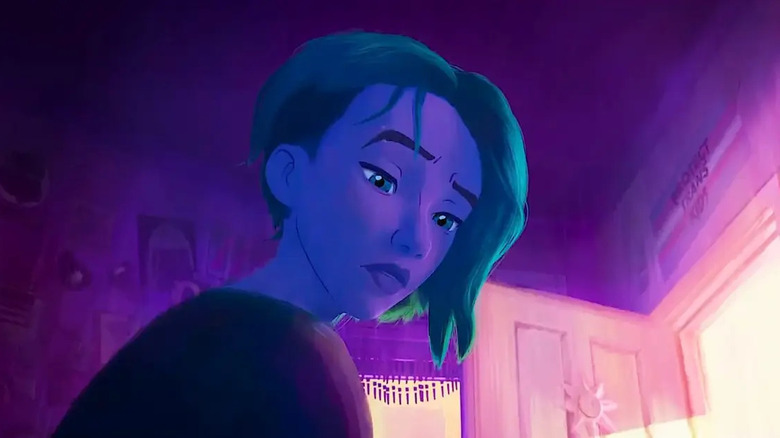The Untold Truth Of Spider-Gwen
In superhero comics, alternate universes — and alternate versions of your favorite characters — are a dime a dozen, whether it's an older Superman who retired due to chronic grumpiness over these kids today, a cool teen future version of Batman, or a whole team of Avengers in shining armor who protect a medieval Manhattan as a sort of ersatz Camelot. With so many different takes on those classic ideas, it takes a truly special character to stick out, and over the past few years, no one has been rocketed to fame as fast as the Spider-Woman of Earth-65, also known as Spider-Gwen.
Her biggest claim to fame came as one of the stars of 2018's dimension-shattering "Spider-Man: Into the Spider-Verse," but that's just the tip of the hard-rocking, web-swinging iceberg that is the multiverse's favorite version of Gwen Stacy. From the tragic origins of her main-line counterpart to the twists and turns that put a truly new spin on a classic superhero idea, here's the truth behind Spider-Gwen.
Gwen and the Goblin
One of the biggest reasons Spider-Gwen made such an impact when she burst onto the page in 2014 was the lasting importance of her counterpart on Earth-616 — the fancy interdimensional designation of the regular, mainstream Marvel Comics Universe. As you probably already know, the Gwen Stacy who debuted in "Amazing Spider-Man" #31 back in 1965 was the first great love of Peter Parker's life, a go-go dancing science major who fell for Peter while they were both in college.
Sadly, she would also be at the center of one of the greatest tragedies of Spider-Man's life. After discovering Peter Parker's secret identity, the Green Goblin abducted Gwen in an effort to hurt Peter as badly as he could. After luring Spider-Man into action, the Goblin tossed Gwen off the top of Manhattan's George Washington Bridge, and while Peter snagged her ankle with a web-line before she hit the surface of the Hudson River, the sudden stop snapped her neck. For readers who were used to seeing heroes triumph against seemingly impossible odds, Gwen's death was an incredible shock — partly because the title of "Amazing Spider-Man" #121, "The Night Gwen Stacy Died," wasn't revealed until the issue's final page.
As one of the first major instances of an established character being killed by a supervillain, Gwen's death marked a turning point, not just for Spider-Man's life, but for superhero comics as a whole. It became ingrained in the very idea of Spider-Man's history, with Gwen herself becoming a symbol of both an idealized past to which Peter could never return, and the cost of his dual life as Spider-Man. As a result, she was one of the few characters whose death was actually permanent. There were a few fakeouts — and a regrettable handful of clones — over the years, but unlike virtually everyone else who has ever died in the pages of a superhero comic, Gwen never came back. In that universe, at least.
Spider-Verse, Take One
Spider-Man has been Marvel's flagship character since about five minutes after his first appearance. He's the guy they put on the letterhead and the paychecks, the one who met Superman in the first big inter-company crossover — he's the character who starred in every issue of "Marvel Team-Up," which didn't even have his name in the title because nobody else is more "Marvel" than Peter Parker. As a result, there are more alternate-universe takes on Spidey than any other character on the House of Ideas' considerable roster.
In 2014, that prominence was used as the basis for an event called "Spider-Verse." The big idea at the center of the story — and get ready, because this is one of the most comic-booky premises of all time — was that a family of interdimensional energy vampires were hunting down the Spider-Men of various universes to satisfy their craving for animal-themed superheroes. As a result, all the surviving Spider-Folks joined together in a multiversal team-up to stop them.
"Spider-Verse" didn't just stop with the deep bench of established versions, tough. Along with established versions like the plodding Spidey of the newspaper strip and Takuya Yamashiro — the Spider-Man of the live-action Japanese TV show from the '70s who had a giant robot named Leopardon and announced himself as "The Emissary of Hell" — there were plenty of new takes. Peni Parker and her robot SP//dr debuted in that story, as did the punk-rock Spider-Man whose costume made it into the 2018 "Spider-Man" PS4 game. The one that seemed to catch everyone's eye, however, swung into action in "Edge of Spider-Verse" #2. Her official codename was Spider-Woman, but when she proved popular enough to launch a solo series after the crossover, it had a more familiar title that explained just who was under the mask: "Spider-Gwen."
Spiders and Hornets
It's no exaggeration to say that the biggest factor behind Spider-Gwen's initial appeal was probably that she had one of the best new costumes of the decade. Even in that stretch of the mid-2010s when a handful of heroines were getting new costumes with more updated, modern sensibilities — including new designs for Batgirl and the main-continuity Spider-Woman — Gwen's was probably the best.
According to writer Jason Latour, also an accomplished comics artist in his own right with work in "Wolverine" and Image's "Southern Bastards," the design was a collaborative process between himself, artist Robbi Rodriguez, and colorist Rico Renzi. Rather than just making a cool suit, which they did, they also ensured that every aspect of it was driven by character. The full mask, similar to the main continuity Spider-Man's, was an indication that Gwen had been branded as a criminal, with the added bonus of allowing readers to imagine themselves underneath it, something that would become a theme in the "Spider-Verse" movie. The spraypaint-style eyes and Chuck Taylor-esque design of her shoes were meant to evoke the DIY attitude of a hero whose day job was playing drums in a rock band. The stark contrast of the white spider silhouette against the black suit— one so subtle that plenty of readers didn't even notice that's what it was — made her pop on the page, especially as a contrast to the predominantly red and blue costumes of the other Spideys. Also, Rodriguez, like many Spider-Artists who have suffered from cramped hands thanks to Steve Ditko's design sense, wanted to draw as few webs as possible.
There was, however, one other element of the design that had more to do with the people behind the scenes. While Gwen herself is a New York City gal through and through, two of her three creators — Latour and Renzi — are from Charlotte, North Carolina. Rodriguez designed the blue and purple accents of the costume with the same colors as the NBA's Charlotte Hornets. Sadly, we've yet to see Spider-Gwen taking a villain to the court to literally dunk on them, but it stands to reason that she'd be pretty good at it.
Secret Origins
One of the most interesting thing about Spider-Gwen's first appearance is that we join her story already in progress. Instead of explaining who she is and how she came to be, her entire origin story was covered in a two-page spread with a grand total of nine panels.
The starting point was exactly the one you might expect: Gwen was bitten by a radioactive spider, got super-powers, and initially used them to pursue fame and fortune. The first big deviation comes in the tragedy that defines her career. Instead of a parental figure dying — her father, police captain George Stacy, is very much alive and a big part of her story — it was a classmate. After a life of being picked on, Gwen's best friend, Peter Parker, wanted super-powers just like Spider-Woman using his own scientific genius. Unfortunately, the formula he concocted had the unforeseen effect of turning him into a hulking monster called the Lizard. It also killed him, and his last words to Spider-Woman were that he did it because he wanted to be like her.
Spider-Woman was blamed for Peter's death, with the crusade against her as a bad influence led, of course, by Earth-65's J. Jonah Jameson. Despite becoming a wanted criminal, Gwen vowed to start using her powers, well, responsibly, driven to fight crime by her guilt over Peter's death. Not a bad setup for two pages.
The Mary Janes
On our familiar Earth-616, Peter Parker's usual source of income as a young college student came from the very millennial job of selling his selfies to an old man — as a freelance photographer for J. Jonah Jameson and the Daily Bugle, that is. Over on Earth-65, Gwen Stacy has taken a significantly different career path: drums!
When she's not moonlighting as Spider-Woman, Gwen plays drums for the Mary Janes, a four-piece rock band made up of familiar faces from the Spider-Man comics — and she's also usually doing the former when she's supposed to be doing the latter, because superhero lives are complicated. The lead singer and lead guitarist, of course, was Mary Jane "Em Jay" Watson, with Betty Brant on rhythm guitar and Glory Grant on keyboard. Before they struck out on their own, though, this quartet had one more member: they were originally known as Black Cat and the Mary Janes, before former lead singer Felicia Hardy ditched them in a successful pursuit of solo success.
The most notable thing about the Mary Janes is that they've also crossed dimensions. They don't just exist in Gwen's world, they exist in ours ... sort of. As "The Mary Janes," indie rock band Married With Sea Monsters put out their version of the band's signature song from the comics, "Face It Tiger," which is named for MJ's iconic opening line in her first (Earth-616) appearance.
Earth-65
The most obvious difference between Earth-65 and the core Marvel Universe comes, of course, from Spider-Gwen herself. She's far from the only change, though, and over the course of 40 issues of her own comic, readers learned plenty of things about just how different that universe really was.
You might expect those changes to be confined to established characters pulled from the main-line "Spider-Man" saga, like Peter Parker becoming the Lizard and Mary Jane Watson rocking out with her own band. It didn't stop there, though. On Gwen's Earth, the Kingpin, Wilson Fisk, was in prison, leaving his criminal empire to be run by his disturbingly amoral lawyer and consigliere, Matt Murdock. Rather than turning away from arms dealing, the Tony Stark of Earth-65 would go all-in, forming a private military company called War Machine, which would go on to recruit a scowling and exceptionally brutal former marine named Frank Castle before he quit to take a job with the NYPD.
Thor and the Fantastic Four don't seem to be a big part of that world — although Reed Richards is a young genius and Ben Grimm is a beat cop who patrols Yancy Street — but they do have a Captain America. Her name is Samantha Wilson, and after Steve Rogers was killed by saboteurs, she volunteered for Project: Rebirth, getting the Super Soldier Serum and fighting in World War II before being lost in the time stream for 75 years.
As for why Gwen's home dimension is called "Earth-65," there are a couple of reasons. Most of Marvel's alternate realities are named for the real-world dates of their first appearances, and Gwen Stacy debuted in 1965. There is, however, an added bonus: the way the comics are lettered, the number 65 bears a striking resemblance to Gwen Stacy's initials.
Gwenom
While they took some very different twists and turns, Spider-Gwen's adventures occasionally drew on existing Spider-Man stories for their inspiration. Naturally, it wasn't long before Gwen found herself confronting her world's version of one of Spider-Man's greatest foes: Venom.
In Gwen's case, her Venom wasn't an alien life form brought back from the Secret Wars. Instead, it was the product of experiment designed to give her back her powers after she'd lost them in a battle with a villain. The formula that turned Peter Parker into the Lizard was exposed to the same radioactive isotopes that had given her her powers, and it formed a new symbiotic organism. You can guess its name.
When Gwen bonded with it — as "Gwenom," because you have to take the opportunity to drop a pun like that when you can — she was going through a particularly rough time in her life. Just as it did to Peter Parker on Earth-616, Gwen's symbiote amplified her aggression and drove her to becoming a much more violent vigilante. It also came with a redesign for her costume, giving her hood a jagged edge and red interior to mimic Venom's traditional huge, pointy-toothed mouth, complete with a tongue-like scarf. Or maybe a scarf-like tongue. Sometimes, it's hard to tell.
The Bodega Bandit
As Spider-Woman, Gwen has no shortage of villains to deal with. Kraven the Hunter. Aleksei Systevich, the Rhino. Matt Murdock, the Kingpin of Crime. Doctorangutan, the doctor who is also an orangutan. Even with all of those sinister foes, there's one that stands above them, one who can truly claim to be Spider-Woman's most determined arch-nemesis: The Bodega Bandit.
Okay, so he's more of an arch-nemesis by virtue of persistence rather than by presenting an actual threat, but still, it counts. The Bodega Bandit. He ... robs bodegas, usually the Dollar Dog, where Gwen likes to get tasty and budget-friendly corndogs. It's pretty simple.
Or is it? Whenever he's (frequently) stopped by Gwen and turned over to the police, he's quickly back out on the streets,m which is pretty weird even for a universe that thrives on recurring arch-villains. According to an "Official Handbook"-style profile in "Spider-Gwen" #33, there's a lot of in-universe suspicion that he's the son of "a rich and influential New Yorker" who pays off the bodega clerks and the cops, since the Bandit is more or less harmless. The profile also suggests that this particular rich and influential New Yorker is J. Jonah Jameson, which would mean that the Bodega Bandit is actually Earth-65's version of John Jameson. Considering that the Earth-616 version is an astronaut werewolf space god who's friends with Captain America, Gwen's version is downright normal by comparison.
Spider-Verse, Take 2
While she was popular enough to spring out of a comic and into multiple solo titles — not to mention being brought onto a handful of TV shows and various video games — Spider-Gwen's biggest claim to fame came in the 2018 film "Spider-Man: Into the Spider-Verse," in which she was one of the main characters.
Generally speaking, the movie changed very little about the character, aside from swapping out her Chucks for ballet flats to emphasize a more dance-inspired fighting style. There's a good reason for that, too: while the movie was being made, Latour, Rodriguez, and Renzi — and Sara Pichelli, who co-created Miles Morales — were brought in as visual consultants. As a result, the sequence of Gwen's origin story, in addition to being done with the same speed that it had in the comics, has the authentic look of the comics, right down to the hot pink highlights.
Ghost-Spider
In her own universe, Gwen initially went by the codename "Spider-Woman," which makes a lot of sense. In the real world, though, that presented something of a problem. Marvel has had several characters in the main universe who have used that name over the years — and a Spider-Girl who had 100 issues about her adventures on Earth-982 — including Jessica Drew. She's the original and current Spider-Woman, who was starring in her own solo series at the exact same time that Gwen was starring in hers.
As a result, Gwen's comic was, of course, called "Spider-Gwen," which makes sense for readers who know about Gwen Stacy and her connection with the Spider-Mythos, but also means that nobody in the actual comic can call her by the name on the cover of her comic. By the time the book came to an end, though, Gwen's identity had been revealed to the public, and everyone started calling her "Spider-Gwen" on that world, too, which ended up being pretty annoying. It might be better than saying "Gwen Stacy, the Spider-Woman of Earth-65" every time you want to talk about her, but still. It's a weird thing to call a superhero — at least in a world where we've all gotten used to calling people "Spider-Man" and "Captain America" like those are normal names for a person to have.
In 2019, Gwen decided to attend college on Earth-616 to get away from a world where everyone knew her identity, and since that universe already has four Spider-Women, she elected for a new codename instead. She settled on "Ghost-Spider," a name that appeared on stuff like toys before it made it into the comics. It's not the best codename, and invites confusion with the guy who rides around on a motorcycle with his head on fire, but for now, it works. It distinguishes her from the others, allows her to have a comic with her codename in the title — even though the comic was initially given the somewhat confusing title "Spider-Gwen: Ghost-Spider" — and perhaps most importantly, it hints at the identity that makes her so interesting by having the same initials as "Gwen Stacy." Oh, and also she picked that name after helping Spider-Man fight a Nazi dinosaur made of bees. No, really.
The origin of her spider
Although Spider-Gwen's origin story is only briefly touched upon in her comic book introduction, later stories featuring the character dive deep into how she ended up one of the strongest Spider-People in the entire multiverse. For instance, few fans of the character probably know about where the radioactive spider that bit Gwen Stacy from Earth-65 came from, because it ties her story together with another Spider-Person: Cindy Moon, who in most universes is the web-slinging superhero known as Silk.
On Earth-65, however, Cindy Moon's story diverges when she misses getting bitten by the spider that's supposed to give her powers. When she realizes this after the fact, Cindy becomes obsessed with the idea of having become a superpowered individual and subsequently makes it her life's mission to reproduce the incident in order to empower her with the abilities of a spider. She eventually forms a terrorist organization known as S.I.L.K. with Earth-65's Jesse Drew and breeds radioactive spiders. One of the spiders that was accidentally released eventually found its way to their universe's Gwen Stacy and turned her into Spider-Woman.
Cindy Moon didn't let this be the end of her involvement with Spider-Gwen, however, and spent many years closely observing the teenage superhero come into her own. After discovering that Gwen was in possession of a device that lets her travel the vast multiverse, Cindy used it to travel to Earth-616 and successfully steal high-grade technology, defeating Spider-Gwen and her Silk counterpart in the process.
The Gwen Goblin
Spider-Gwen has encountered many villains throughout her comic book history, from the greatest foes of Earth-616's Spider-Man to her own unique antagonists and supervillains. However, Spider-Gwen has also faced the toughest enemy of them all. In the "Spider-Gwen: Ghost Spider" comic book series that debuted in 2018, Gwen becomes stranded in an unknown universe, where she finds herself hunted by the Green Goblin, the same supervillain who killed Earth-616's Gwen Stacy, but is surprised to discover this universe's Green Goblin is a variant of herself.
As it's later revealed, Gwen Stacy adopted the Green Goblin persona on Earth-3109 after Harry Osborn became bitten by a radioactive spider and became Spider-Man. After designing the Green Goblin's tech for herself, Gwen teamed up with Osborn to defend New York City from threats, until Gwen's father, George, unfortunately died at the hands of Sandman. Like Norman Osborn's Green Goblin, this triggered a severe change in Gwen Stacy, who became consumed by the evil Green Goblin personality.
Upon Spider-Gwen's arrival, Earth-65's Gwen teams up with Peter Parker and Mary Jane to track down their Gwen Stacy and save her from herself. In return, Earth-3109's Gwen Stacy helps Spider-Gwen design the ticket to the multiverse, a device that allows Spider-Gwen to safely jump between dimensions by bonding with her DNA. The ticket to the multiverse has since been reproduced and used by many other Spider-People across different universes, but it all started due to one Gwen Stacy variant's unfortunate descent into madness.
Changing the narrative
While Marvel Comics fans were immediately drawn to the design of Spider-Gwen, for her creators, turning Peter Parker's most iconic damsel in distress into a superhero had more motivations behind it than a cool costume. Spider-Gwen was first introduced in the comics by writer Jason Latour during the "Spider-Verse" story arc in 2014, and the character's popularity prompted Latour to write a solo series focusing on the character with Robbi Rodriguez helming the art design.
However, Latour initially had reservations about bringing such an iconic Marvel Comics character back from the dead. He only relented, he said, when he considered the possibility of creating a depiction of Gwen Stacy that wasn't killed off for the purposes of developing Peter Parker's character. As Latour told USA Today about resurrecting the character for a new audience, "There was a catharsis to, well, if this character could come back and escape death because of what superhero comics are best at doing, then the sky's the limit."
Thankfully, Latour's instincts paid off, as Spider-Gwen has been one of the more well-received iterations of Spider-Woman in years. Particularly, comic book critics praised the character's individuality not only compared to previous iterations of the Gwen Stacy character in the comics, but even compared to other Spider-Women like Jessica Drew or Julia Carpenter. Through creating a well-thought-out backstory for Earth-65's Gwen Stacy, Latour transformed her from a plot device doomed to be killed into a superhero capable of leading a franchise of stories.
Meeting her future children
While those who have seen "Spider-Man: Across the Spider-Verse" may think they know a lot about the romantic possibilities between Miles Morales and Gwen Stacy, the comic books are quite a different story. The two web-slingers didn't explore their potential for love until the 2017 comic book crossover arc "Sitting in a Tree," written by the respective creators of the two characters, Brian Michael Bendis and Jason Latour. Their romance begins when Miles travels to Gwen's universe in search of his missing father.
As their supportive romance blossoms on their multiversal adventure, Miles and Gwen make quite a shocking discovery when they end up on Earth-8, where their superhero personas are not only celebrities but also married with children. The Miles and Gwen of Earth-8 subsequently formed a superhero team known as the Amazing Eight, which included themselves, their kids Max and Charlotte, Spider-Ham, SP//dr, and others.
Though Miles and Gwen ultimately team up with their alternate future children to defeat the Scorpion, Gwen is spooked by the idea that fate is controlling their being together and insists they remain friends. It's at least heartwarming to know that in one alternate reality, Miles and Gwen had a long-lasting romance for over 20 years. Sadly, the fate of Earth-8's Miles and Gwen may not be shared with their "Across the Spider-Verse" counterparts, given the 2023 animated film centers strongly on the idea that Miles is defying fate by opposing the Spider-Society's insistence that his father must die.
One of a kind
Compared to some other Spider-People from across the multiverse, Spider-Gwen is relatively new to the whole superhero thing. As of her most recent comic book appearances, Gwen Stacy is still a college-aged young woman who engages in her Spider-Woman vigilantism on the side. However, even at a young age, Spider-Gwen has already made quite a name for herself among the many Spider-People from other dimensions. In her first comic book appearance, Gwen is offered a spot on Spider-UK's Spider-Army after Spider-People are being hunted by Morlun and his Inheritors.
Gwen eventually is recruited by Spider-People to help protect the multiverse from destruction during the 2015 Spider-Man comic book arc "Worldwide" and is later offered a position on the Web-Warriors, tasked with helping other realities who have lost their Spider-People. It's during this era of Spider-Gwen's superheroism that she discovers that not only is she the only Gwen Stacy to have become Spider-Woman, but she's one of the few Gwen Stacys to not have been killed.
Though this could be enough to crush Gwen, she finds a confidante in Earth-616's Peter Parker, whom she relates to due to his own guilt over losing his Gwen. She's later advised by Earth-616's Jessica Drew, another Spider-Woman, to let go of what happened to both Earth-616's Gwen Stacy as well as Peter Parker of her own Earth-65 and to focus on being the best superhero she can be not just for her universe, but for all the Spider-Verses out there.
Into the Gwenverse
Earth-65's Gwen Stacy has encountered her variants before in the comics, but in the recent solo adventure "Spider-Gwen: Gwenverse," something much stranger happens. After a mishap with her ticket to the multiverse, Gwen falls through a multiversal portal and is rescued by Spider-Zero, who takes her back to Earth-65 to discover it's been rewritten into a new universe. Additionally, the temporal pulse that caused Gwen's ticket to the multiverse to malfunction also split her essence into five different Gwen Stacys, all with different powers relating to popular Marvel superheroes.
These five new Gwen Stacys whom Spider-Gwen initially encounters include Captain America, Wolverine, Thorgwen, Iron G.W.E.N., and Captain Marvel. Furthermore, these five new Gwens all embody different aspects of Spider-Gwen's personality, such as Wolverine embodying her rage while Thorgwen captures her selfishness. Though they have difficulty getting along, the six Gwens must come together to face the Terminal Six, a multiversal society of supervillains formerly led by a version of Gwen masquerading as Nightbird.
Although Captain Marvel is killed, the self-proclaimed Gwen-Vengers recruit Nightbird to face their true enemy, Finale the Ultimate Artist. Though the other Gwen-Vengers have to sacrifice themselves to save Spider-Gwen, defeat Finale, and save the multiverse, Gwen ends this story by learning to love herself a little more, even the less favorable parts. "Spider-Gwen: Gwenverse" is a must-read story arc for any and all fans of Spider-Gwen, as many comic book fans appreciated this deep dive into a beloved character from the Spider-Verse.
Guin Stacy
Spider-Ham is known behind the mask as Peter Porker, the spider who was transformed into a pig with a spider's abilities. He's a much different character than Spider-Gwen when it comes to the comics. Although they both made their screen debut at the same time in "Spider-Man: Into the Spider-Verse," the character of Spider-Ham goes back way further than Spider-Gwen, making his comic book debut in a 1983 one-shot comic and making recurring appearances ever since, notably as a member of the Spider-Army during the 2014 "Spider-Verse" story arc and during the "Marvel Zombies" storyline.
Spider-Ham and Spider-Gwen also team up together in 2015's "Secret Wars" story arc after Gwen rescues him from captivity in Battleworld under Norman Osborn, later joining forces with other Spider-People including Spider-Man Noir, Spider-UK, and Spider-Man India. The two also reunited in the fifth chapter of Spider-Gwen's 2016 annual series, where they team up to battle the Swinester Six, who are comprised of anthropomorphic versions of Spider-Man enemies including Doctor Octopussycat, Ducktor Doom, and Raven the Hunter.
However, this comic book also features a cameo from Spider-Gwen's own variant from Spider-Ham's universe: Penguin Stacy aka Spider-Guin. In their universe, Spider-Guin and Spider-Ham teamed up to traverse the multiverse after Spider-Ham's enemies were scattered across it. It's a more humorous moment from Spider-Gwen's comic book history, but it's one that showcases that perhaps she's not the only Gwen Stacy to become a superhero, given that her penguin variant also dons a similar-looking white-and-black costume.
Gwenpool
Upon Spider-Gwen's initial release in 2015, Marvel recognized the characters' popularity amongst their fans and celebrated the character by reproducing variant covers of 20 different comic releases around that time featuring Gwen Stacy as various Marvel characters. Alongside issues depicting Gwen as the Incredible Hulk, Wolverine, and Doctor Strange, many fans' attention was caught by one depiction of Gwen as Deadpool for an issue of "Deadpool's Secret Secret Wars." The popularity of this variant cover alone spawned many fans to start cosplaying as the character, later called "Gwenpool."
Once again in response to Gwenpool's popularity, Marvel issued a solo series for the character in 2015. They turned the design into a Marvel Comics superfan named Gwendolyn Poole who ends up in the Marvel universe and decides to don the superhero persona of Gwenpool. Like Deadpool, she's a much more lighthearted character, utilizing her knowledge of comic books and fourth wall-breaking abilities to her advantage. In 2016, Gwenpool transitioned to her own ongoing solo series with "The Unbelievable Gwenpool."
Gwenpool became a major step in representation for Marvel Comics. In a 2023 issue of "Love Unlimited: Gwenpool," Gwen faces a conflict with her sexual identity and later comes to the understanding that, in what's become a huge moment for Marvel, she's the first canon asexual and aromantic character in their history. Speaking on the decision, color artist Kelly Fitzpatrick told Marvel, "I feel so lucky to have been a part of this entirely acespec team and story."
The voices behind Spider-Gwen
Hailee Steinfeld has received lots of acclaim for her voice performance as Spider-Gwen in "Spider-Man: Into the Spider-Verse," as well as its recent sequel, "Spider-Man: Across the Spider-Verse," where she is more in focus. Though Steinfeld is no stranger to the Marvel universe, also playing Kate Bishop in the live-action Marvel Cinematic Universe series "Hawkeye," she's not the first to lend her vocal talents to Spider-Gwen. Dove Cameron, of Disney Channel fame, was the first to voice the character in a 2016 episode of Disney XD's "Ultimate Spider-Man" series.
Cameron also reprised her role as the character in several shorts for "Marvel Rising," but she's not the only voice actress to portray the character of Spider-Gwen numerous times. Laura Bailey, known for her work in "The Last of Us: Part II," "Fire Emblem Awakening," and "Critical Role," voiced the character as part of the main cast of the Disney XD animated series "Marvel's Spider-Man," which aired from 2017 to 2020. Bailey reprised her role in the "LEGO Marvel Spider-Man" episode "Vexed By Venom."
In addition to Laura Bailey, her "The Last of Us" and "Critical Role" co-star Ashley Johnson portrayed Spider-Gwen in the MMO video game "Marvel Heroes," while Bailey continued to voice the character in the smartphone game "Spider-Man Unlimited." Other voice actresses who have been behind the Spider-Gwen mask include Emily Tennant in Disney Jr.'s "Marvel Super Hero Adventures," as well as Melli Bond in the video game "LEGO Marvel Super Heroes 2."
Gwen's gender identity comes into question
Gwen Stacy's "Spider-Man: Across the Spider-Verse" appearance has attracted fan discussion online over whether or not the character is the first feature film appearance of a trans Marvel superhero. In the comics, the sexuality of Gwen Stacy and her variants is often subject to different interpretations, though "Across the Spider-Verse" would mark the first time the character may be interpreted as having a non-cisgender identity. Though nothing's been officially confirmed by the film's creators, the clues hinting at Gwen's identity are all there.
Namely, Spider-Gwen's native Earth-65 is often seen using the color palette of the blue, pink, and white transgender flag. These colors are certainly no accident, as Hailee Steinfeld herself told Cinema Blend that the intent behind its design was to reflect Gwen's emotional state, saying, "It's like a mood ring, it will visually change as her circumstances change." Fans have certainly caught on to the intent behind this color scheme, especially due to Gwen's internal struggle with her identity as Spider-Man resonating with transgender fans of the film.
If that wasn't enough evidence, one scene in the film depicts a "Protect Trans Kids" flag hanging in Gwen Stacy's bedroom, which certainly alludes to the idea that Gwen at the very least identifies somewhere along the gender spectrum. Although the flag's appearance might also be the filmmakers showing their own solidarity with the transgender rights movement, or showing the character's solidarity in the film, it could also hint at something even deeper behind Gwen's mask.
